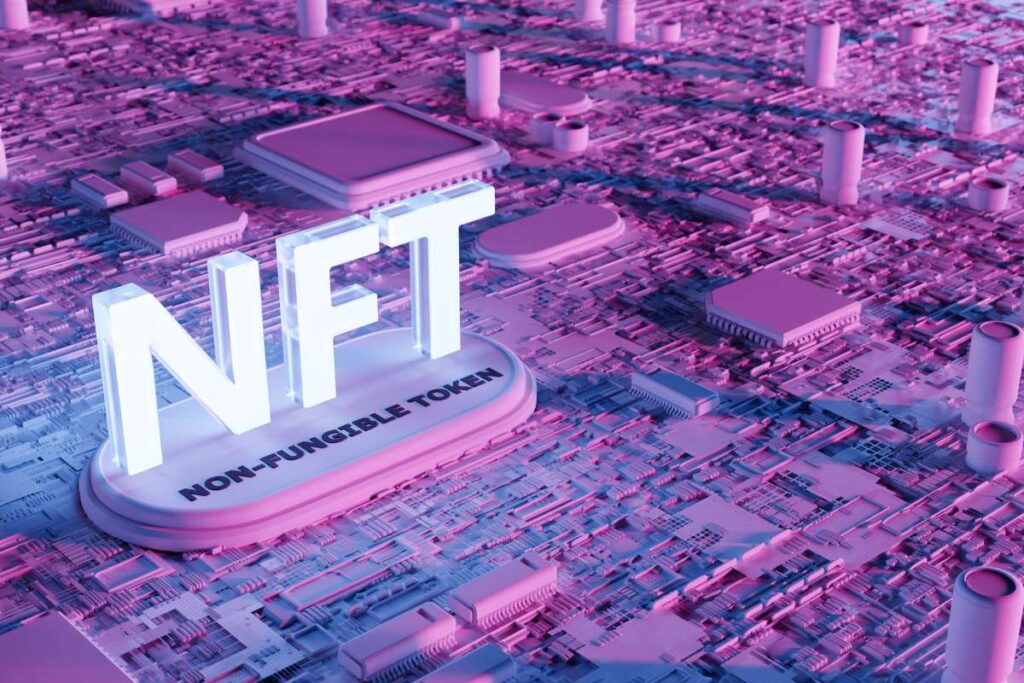In this fast-paced world, digitization is becoming routine and a norm. With the ease of access, short transaction time, well-documented details, and proofs, digitizing every aspect of life is welcomed with open arms. The case is similar for trade and commerce.
“NFTs are digital real estate, and it is going to be worth a lot more than real estate”
Anuj Jasani, CEO of Just Brandable
With so many platforms available for the same, competition is inevitable. The deciding factors thus boil down to security and profits, among others.
Like every market, we can easily spot cutthroat competition in the digital market. The fact that this is a relatively new market amplifies the competition. There’s always competition within the different platforms and companies to attract businesses and increase their profits and reputation. They try to achieve their goal by hook or crook, and we often see these examples as headlines in various newspapers and tabloids.
The new age of decentralized financing has paved the way for a completely new and undiscovered market.
In this article, we shall first discuss the basics of NFTs and then discuss one such piece of news about the migration of projects from one platform to another. Polygon has paid Y00ts and DeGods, the top projects of Solana, $3 million to migrate their chains to their platform.
What is an NFT?

The hype of NFTs has exploded in the last few years. The trade of NFTs in 2020 totalled $82 million, increasing by 21,000% to $17 billion in 2021. Nowadays, NFTs are being sought as the digital solution to collectables.
Non-fungible tokens, often called NFTs, are digital, unique, collectable tokens recorded on a blockchain like an art piece or a trading card. The term “non-fungible” literally means property that buyers cannot exchange for other items due to their unique property. Ethereum cryptocurrency’s blockchains are where the majority of these NFTs reside. These blockchains function like a distributed public ledger used to record different transactions.
All NFTs are individual tokens whose value is set by the market and demand. These NFTs store valuable information in them. These NFTs are recorded proof of ownership and authenticity. They can also be used as an investment vehicle by buying unique and ancient art pieces or digital properties. Since NFTs are linked to a blockchain, they obtain a unique digital identifier which ensures that these can’t be copied, substituted, or divided, unlike the cryptographic assets.
Digital content is the most important use of NFTs today. Gaming items, investments, and collateral are some of the other main benefits of NFTs. From buying characters and privileges in games to borrowing money and domain names, NFTs are the one-stop solution for all.
These cryptographic assets have given lease to a new market for digital artists and have opened the market to everything on the internet. The first tweet by Jack Dorsey, when tokenized, was sold for more than $2.9 million. Massive increases have been observed in sales due to the new route and the new audience.
What are Polygon and Solana?

Polygon, formerly known as Matric, is a platform that serves a dual function as a cryptocurrency and blockchain scaling platform. It supports over 7,000 decentralized applications (DApps) on its platform. MATIC, the native cryptocurrency token of Polygon, holds the 10th position among all crypto projects by market cap. It also ensures its security as a result of the validation system and provides a multi-chain architecture to enhance the scalability of the projects.
Solana is a secure, fast, and censorship-resistant platform that implements multiple technologies to run and support several smart contracts simultaneously, thus saving a lot of time by following different blockchain nodes in smaller packets, making it a cost-effective blockchain. It follows stateless architecture and has a high-performance protocol to aid the scalability of projects.
“If you are an artist and still don’t use NFT (Non-Fungible Token), you are potentially missing millions of dollars.”
Olawale Daniel, Founder, TechAtLast
What exactly happened?
On 6 January 2023, the NFT developer of Y00ts and DeGods, DeLabs, based in Los Angeles, was paid $3 million to migrate their blockchains to Polygon from Solan. Their developers made preliminary information about this transition on 27 December 2023.
According to reports, the team claims to use this money to expand its staff strength. In a statement, the Y00ts and DeGods founder, Frank III, claimed that they had received even higher amounts of money from other companies, but they decided that Polygon would be the best platform for the projects. This implies that the platforms’ shift was fueled by monetary benefits and the project’s welfare and ensuring its steady growth.
Y00ts is a generative art project and is worth 15,000 NFTs. On the other hand, DeGods is a 10,000-edition collection of digital art. These were among the top projects built on Polygon’s competitor Solana’s blockchain.
The grant is a non-equity one and will help in team expansion and kickstart and scale the initial phase of the incubator that is being built to allow people to spend y00tpoints and DePoints to mint the NFT collections of their incubators. They will also focus on developing their business, content creation, graphic designing, and event coordination.
The projects’ leader Rohan Vohra also known as Frank, also claimed that this grant will help them launch higher quality projects and focus on providing attractive partnerships, deals, discounts, and perks with real businesses for the customers.
The DeGod’s team also squashed rumours claiming they had demanded $5 million from the Solana foundation to stay on their network instead of shifting.
Several renowned and successful brands have also gotten on board with Polygon, including Starbucks, Nike, Reddit, and Instagram.
What does this move mean for Solana?
Transferring two of their top projects to a competitor’s platform was undoubtedly a massive blow to the Solana foundation’s trade, reputation, and future.
This move landed a blow to Solana, whose native cryptocurrency, SOL, has seen a continuous drop since its peak in November 2021 of a high $258. Recently, SOL was observed hovering around the value of $13.
It has been claimed that this transfer can lead to the end of Solana since, according to the data from the NFT marketplace Magic Eden, the sales of goods and Y00ts made up nearly 70% of the entire NFT sale volume of Solana.
Another reason this transfer was widely regarded as a potential death blow to the Solana network is that Solana was already under strain due to the fallout from the collapsed FTX exchange, which was a massive setback for the company.
At least for now, Solana may have recovered from the migration of y00ts and DeGods due to meme coins like Bonk still attracting trading activity towards their platform. However, the future of the Solana foundation is still in great uncertain.
Polygon vs Solana: Which is better?
From a larger perspective, Solana and Polygon deal with the issue of tackling the scalability issues of Etherium, but both have their own sets of pros and cons. We shall compare them based on prominent deciding factors commonly used to evaluate different blockchain systems.
Transaction Speed
The transaction speed offered by blockchains is one of the essential factors when comparing blockchain platforms. A higher transaction speed implies that the blockchain can handle more transactions.
Solana uses tBFT, defined as Tower Byzantine Fault Tolerance, and Gulfstream to enhance its transaction speed by eliminating the need for real-time communication and pushing the transactions toward the end. Solana blockchains can handle more than 50,000 transactions in a second.
On the other hand, Polygon can handle more than 65,000 transactions in a second and can scale even further in the future. This data implies that Polygon is undefeated in terms of transaction speed.
Tokenomics
Both Polygon and Solana share multiple similarities in the field of tokenomics. They use rewards to incentivize their users, which also helps secure the network. Both platforms offer a similar average staking reward of around 8% returns.
However, Solana has an inflation rate of 8%, less than the inflation rate of Polygon, which is about 10%. This data infers that Polygon mints more tokens in comparison to Solana. This shows that Solana is better in tokenomics as compared to Polygon.
Consensus
Consensus is a mandatory procedure standard in all platforms offering decentralized blockchains. In the present state of the network, it aids in reaching a common ground. It refers to a computational and mathematical algorithm that helps a group of network nodes decide if the transactions are valid and eligible to be recorded on a blockchain.
In Polygon, they can obtain a consensus based on the Proof of Stake called PoS. Polygon offers an assortment of technologies that helps in achieving consensus quickly.
Solana uses a hybrid form of consensus, combining the best features of PoW, PoS, and PoH, defined as Proof of History.
Scalability
Scalability is one of the factors that act as a hindrance to the progress of some of the most prominent blockchains. It shows whether the blockchain can scale enough to complete a transaction.
While both Solana and Polygon are free from the issues of scalability, they do have a difference.
Solana uses improved architecture, high transaction speed, and an efficient consensus model to ensure increased scalability.
Polygon uses lightning-speed transactions, which makes the platform extremely fast, scalable, and efficient. This helps Polygon in beating Solana in scalability.
Architecture
The architecture of a blockchain describes if the blockchains can modify the variable and also throw light on its state. Architecture can be divided into stateless and stateful depending on whether the blockchain variables can be modified.
Polygon architecture is based on a borderless community in which the exchanges are carried out in clusters. This indicates that the system functions similarly to a POS blockchain.
Solana architecture is based on cluster architecture, where validators address transactions with the ledger. This ensures that the entire architecture is not updated every time.
Thus, although both Polygon and Solana offer diverse architecture, they have their drawbacks and advantages, rendering it challenging to choose either.
User Experience
In the end, any service aims to ensure the customer’s satisfaction to ensure more traffic and profit on the platform.
Solana needs to catch up in user experience as the network is incompatible with EVM, making it difficult to move funds from Solana to other networks or vice-versa.
Polygon, on the other hand, is EVM compatible, increasing the efficiency of transactions and improving the user experience.
“If you are an artist and still don’t use NFT (Non-Fungible Token), you are potentially missing millions of dollars.”
Olawale Daniel, Founder, TechAtLast
Conclusion
As the market shifts towards decentralized financing, cryptocurrency and NFT have become famous. This has opened an opportunity for various competing platforms to create a space for themselves and gain a reputation and standing. The NFTs’ have the edge over physical transactions like easy availability, security, and equal access. It has given digital creators a new lease on life and a platform to showcase their art and earn from it.
This DeFi market is filled with competition, where every company wants to better the others by hook or by crook. In one such situation, Polygon paid $3 million to shift the blockchains of two among the top projects of their competitor Solana.
This move will prove detrimental for Solana, which was already not in its best position from some time in the past. The fallout from the collapse of the FTX exchange had put the company under immense pressure, which might be considered a deadly blow to Solana. Further, we saw the standing of these companies against each other on criteria like transaction speed, tokenomics, consensus, and scalability, among others.
We hope you found this article to satisfy your curiosity and answer any questions.
We at Coinxwire offers number one business blockchain and crypto news network on the planet.
Frequently Asked Questions(FAQs)
- Why are NFT art pieces so expensive?
Ans: Just like art in the physical form, the digital NFT art’s value is also decided through multiple factors like the probable resale amount, popularity of the artist, message, and emotions attached to the art. NFT art’s value is also determined by the hard work put into it and the intricacies of the art.
- What are the risks involved in NFTs?
Ans: NFTs fall under the high-risk, high-reward investment system. It is advised to investors not to stake their financial security against NFTs. There is multiple cyber security and scamming challenges in NFT transactions. Investors must also beware of fraudulent NFTs.
- Is it possible to make money from NFTs?
Ans: NFTs, like stocks, can be traded when their values fluctuate. Thus it is profitable to buy them at a lower value and sell them when their values rise. There are multiple factors regarding the monetary value of NFTs. So, it is beneficial to consult a professional before trading NFTs.













